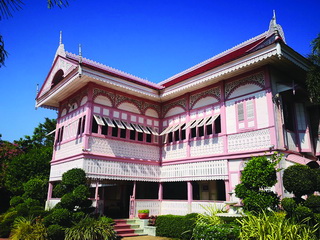The Architecture of Khum Chao Nai, the House of the City Governor, in Phrae Province
Main Article Content
Abstract
The architectural study of Khum Chao Nai, the House of the City Governor in Phrae Province, delves into the distinctive characteristics prevalent during the reigns of King Rama V through King Rama VII. This research encompasses eight case studies: Khum Chao Luang, Khum Wong Buri, Khum Wichai Racha, Khum Chao Nan Chaiwong, Khum Wong Phra Thang, Ban Khattiyawara, Ban Luang Sri Nakaranukun, and Luang Sri Nakaranukun’s Residence. These structures, influenced by Western architectural concepts and construction techniques, as well as Chinese stick-style elements, showcase a harmonious integration with the local Lanna culture. The study employs a comprehensive methodology involving field surveys, literature reviews, research, and archive examinations. The objective is to analyze Khum architecture, comparing and contrasting its characteristics with other structures in the northern region during the same historical period.
The research further extends to comparing Khum architecture in Phrae Province with the residences of Chao Nai and the affluent in Bangkok from the same era. Emphasizing field research, the study seeks to uncover the origins and characteristics of Khum architecture in Phrae Province. The Stick Style architecture in Phrae Province is classified into three categories: Stick Style Wallbearing Structure, Stick Style Wooden Structure with Fretwork-Decorated Gable, and Late Stick Style Wooden Structure. The evolution of late wooden structures draws inspiration from ancient houses in Phayao Province. Additionally, the ornamental fretwork on late Stick Style wooden structures is categorized into Floral pattern fretwork, Floral patterns combined with zodiac animal fretwork, Auspicious Chinese fretwork, and Geometric fretwork.
The Khum architecture in Phrae Province during the Rattanakosin Era, when Phrae was under central administration (Bangkok), holds significance in political, administrative, economic, and societal contexts. This architectural style, blending Western influences with Lanna culture, symbolizes the transformative period in Phrae Province, particularly the widespread adoption of the Stick Style. Materials, building techniques, plans, and fretwork details on gables and eaves serve as indicators, demonstrating a brilliant fusion of Lanna’s wooden architecture with Western design.
Downloads
Article Details

This work is licensed under a Creative Commons Attribution-NonCommercial-NoDerivatives 4.0 International License.
References
Channarong Srisuwan. Rư̄an Lān nā læ lūatlāI pradap ʻākhān praphēt khum læ thī yūʻāsai khanāt yai nai khēt phāk nư̄a [Lanna Houses and Ornamental Works of Khum and Large Domes tic Architecture in Northern Thailand]. 2nd ed. Chiang Mai: Lanna Architecture Center, Faculty of Architecture, Chiang Mai University, 2019.
Kanchana Laotrakul, Owner of Khum Wong Phra Thang. Interview, November 22, 2020.
Kittirat Thavorn, Owner of House No. 8. Interview, November 23, 2020.
Naengnoi Suksri, MR., Napit Krittikakul and Darunee Kaewmuang. Phra rāt cha wang læ wang nai Krung Thēp (Phō̜. Sō̜. sō̜ngphansāmrō̜iyīsiphā thưng sō̜ngphanhārō̜iyīsiphā) [Palaces and Royal Residences in Bangkok (1782 A.D.-1982 A.D.)]. Bangkok: The Research Project of Thai Art and Culture over 200 Years of the Rattanakosin Kingdom, Chulalongkorn University, 1982.
Narit Wattanaphu. Lūatlāi chalu [Fretwork]. Bangkok: Mitsumphan Printing Company Limited, 2011.
Nopporn Hatta. Khum čhaonāi Lān nā [Houses of the Lanna City Governors]. Bangkok: Wanchana, 2002.
Nor Na Paknam [pseud.]. Bǣpphǣn bānrư̄ an nai Sayām [Patterns of Traditional Houses in Siam]. Bangkok: Muang Boran, 1988.
Phuchai Kuamsap. Lāimai chalu bǣp khanom pang khing suntharīyaphāp hǣng krung Rattanakōsin [Stick-style Fretwork: the Beauty of the Rattanakosin Period]. Bangkok: Office of Archaeology, Fine Arts Department, 2017.
Pirasri Povatong. Chāng farang nai krung Sayām : ton phǣndin Phraphutthačhaolūang [European Builders in Siam: the Early Part of King Rama V’s Reign]. Bangkok: Faculty of Architecture, Chulalongkorn University, 2005.
Pussadee Tiptus and Manop Bongsadadt. Bān nai Krung Thēp : rūpbǣp kān plīanplǣng nai rō̜p sō̜ngrō̜i pī (Phō̜. Sō̜. sō̜ngphansāmrō̜iyīsiphā thưng sō̜ngphanhārō̜iyīsiphā) [Houses in Bangkok: Characters and Changes During the Last 200 Years (1782 A.D. - 1982 A.D.)]. Bangkok: The Research Project of Thai Art and Culture over 200 Years of the Rattanakosin Kingdom, Chulalongkorn University, 1982.
Sarun Srithawatpong. “Rūpbǣp sathāpattayakam Lān nā khanom pang khing : Khum Wong Burī čhangwat Phrǣ [Lanna Stick Style Architecture Case Study of Khum Wongburi House, Phrae Province].” Master’s Thesis, Chulalongkorn University, 2017.
Somchart Chungsiriarak. Sathāpattayakam bǣp tawantok nai Sayām samai ratchakān thī sī thưng Phō̜.Sō̜. sō̜ngphansīrō̜ipǣtsip [Western Architecture in Siam during the Reign of King Rama IV - 1937 A.D.]. Bangkok: Faculty of Architecture, Silpakorn University, 2010.
Sompit Kattiyawara, Owner of Ban Khattiyawara. Interview, November 23, 2020.
The Active Generation of Phrae Family. “Khum čhaolūang mư̄ang Phrǣ thanon Khum Dœ̄m tambon Nai Wī ang ‘Amphœ̄ Mư̄ang čhangwat Phrǣ [Khum Chao Luang, Khum Doem Alley, Tambon Nai Wiang, Mueang Phrae District, Phrae].” Journal of Department of Public Works and Town & Country Planning 45 (2015): 33-36.
Theerawut Klomkaew. “Nǣothāng kān‘anurak rư̄an mai phư̄n thin nai khēt thētsabān mư̄ang Phrǣ [A Conservation Guideline for Vernacular Wooden House in Phrae Municipality Area].” Master’s Thesis, Chiang Mai University, 2009.
Veera Star, Owner of Khum Wichai Racha. Interview, November 25, 2020.

